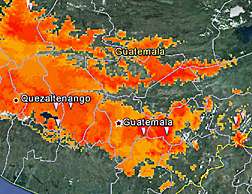An interactive atlas to preserve agricultural biodiversity

U.S. Department of Agriculture (USDA) scientists and cooperators have developed an interactive atlas of wild plants in Guatemala that are closely related to crop plants. The atlas will make it easier to preserve plants with genes that may be vital to global food security.
The Atlas of Guatemalan Crop Wild Relatives, accessible using a Google Earth interface, gives researchers and the public access to decades of data assembled by dozens of plant collectors in one of the richest regions of biodiversity in the world, according to Karen Williams, a botanist with the Agricultural Research Service (ARS) National Germplasm Resources Laboratory in Beltsville, Md. ARS is USDA's chief intramural scientific research agency, and this research supports the USDA priority of promoting international food security.
Of the 105 species of plants included, eight occur only in Guatemala, according to Williams, who worked on the atlas. Plant species were selected based on their importance to both world and Guatemalan agriculture.
The atlas is designed to provide Guatemalan scientists and land managers with information on where these crop wild relatives grow, which ones are most at risk, and which may be safe from habitat destruction. Scientists can use it to identify areas in need of protection.
Many of Guatemala's native plants are closely related to some of the most important crops in the United States, including corn, beans, peppers and potatoes. These crop wild relatives have genes that may be useful in addressing threats posed by emerging diseases, insect pests, and temperature and rainfall extremes arising from a changing climate.
Williams was part of an international team that spent 10 years working on the atlas. The researchers tracked down and compiled some 2,600 records of scientific specimens, which included when and where the plants were found, the appearance of the plants and descriptions of their native habitats. They consulted records from numerous germplasm collections and collections of dried plant specimens preserved in the United States, Guatemala, Honduras, and Mexico.
The atlas is currently available in Spanish only. Williams and her collaborators are translating it into English, and that translation is expected to be available within the year. The atlas and supporting data are available at www.ars.usda.gov/ba/atlascwrguatemala.
Read more about this research in the March 2013 issue of Agricultural Research magazine.
Journal information: Agricultural Research
Provided by Agricultural Research Service

















